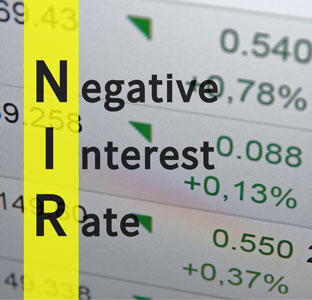What Do Negative Interest Rates Mean?
As we write, there is approximately $13 trillion (yes, trillion dollars) in sovereign debt (debit issued by governments) now trading with a negative yield. What exactly does that mean?
Definition: Negative interest rates are an unconventional monetary policy tool (use of interest rates and money supply to influence economic activity) employed by central banks. They set nominal target interest rates (for example, Federal Funds rate) below zero. This policy is relatively new (since the 1990s) and is implemented to lessen a financial crisis.
Negative Interest Rate Policy (NIRP): Stated simply, this policy means that a Central Bank (and even private banks) charge negative interest rates. So, instead of earning interest on your bank deposits or CDs, you (the depositor) pay regularly to keep your money in the bank. Interest rates are typically assumed to be the price paid to borrow money. Amazingly, negative interest rate policy is a situation where the creditor pays the borrower, not the other way around!!
Typically, deflationary periods cause people and businesses to hoard money. Instead of investing and spending, people hang onto their money in the belief that prices will be cheaper in the future. Historically, this behavior leads to a collapse in demand – prices of goods do keep falling, production and output declines, and unemployment increases. Deflationary spirals are very hard to stop, and loose monetary policy (lowering interest rates) is the usual method. The problem intensifies if the deflationary forces are strong enough, cutting the Central Bank’s interest rate to zero may not work in stimulating lending and borrowing. NIRP may be considered the last resort, in an effort to boost economic growth. It is put into place when all other traditional policies have not worked or failed.
In recent weeks the three largest Central Banks – Federal Reserve (FED), Bank of Japan (BOJ), European Central Bank (ECB) – have signaled their willingness to move rates lower again to try and keep or spur economic global growth. Currently the BOJ policy rate is -0.10, the ECB deposit rate is -0.40 and the FED funds rate is 2.38%. The difference between the US and the other major developed countries is huge. World interest rates move with the perception of world growth. Right now, the US is the outlier when you compare interest rates and growth. But even though the US is still growing, we and the rest of the world are slowing. This puts pressure on the FED to lower rates, compared to any other option, and move more into line with the other two Central Banks interest rate policies.
There is talk of the possibility that future US interest rate policy may need to go negative as well. The problems with this policy are real for Japan and Europe. Low and negative interest rates have not curbed deflation or recessions, and economic growth has stagnated. Federal Reserve Chairman Jerome Powell has inherited a very difficult situation. The data that economists and the FED look at to determine continued growth or slowing growth is mixed, and voices of malcontent with their interest rate policies so far are front and center in the press. We believe Chairman Powell would prefer not to lower interest rates and try to normalize markets. However, the market, not economists, are telegraphing in no uncertain terms that the FED needs to lower rates. The fear is the longer they hold off lowering interest rates, the more harm is done to the economy. We will know the answer at the end of July when the FED meets to make their decision on interest rates. At this juncture, we are hoping for a stable or slow growth economy, whichever decision the FED makes.
Market Commentary:
The first half of 2019 has been incredibly good for both the bond and stock markets. Coming off the month of December – the stock market was down by about 20% and bond prices were down (interest rates increased which means bond prices go down) — the market was signaling that it looked like the Federal Reserve would choke off economic growth with their interest rate increases. Chairman Powell and the Federal Reserve Board did a U-turn right after the first of the year (the FED changed forward guidance and started talking about lowering interest rates). The market was telling the FED they were too tight with interest rates and needed to back off. And back off they did. The promise of lower rates going forward is still working its magic for the markets. As we have said before, uncertainty creates unsettling times in the markets, but it also presents opportunity for the future. For now, we continue to maintain some cash reserves and a conservative investment posture, but we are ever hopeful that opportunities will be created for the long term.
We appreciate and thank you for the trust and confidence you have placed in Occam Capital® Management, LLC.

